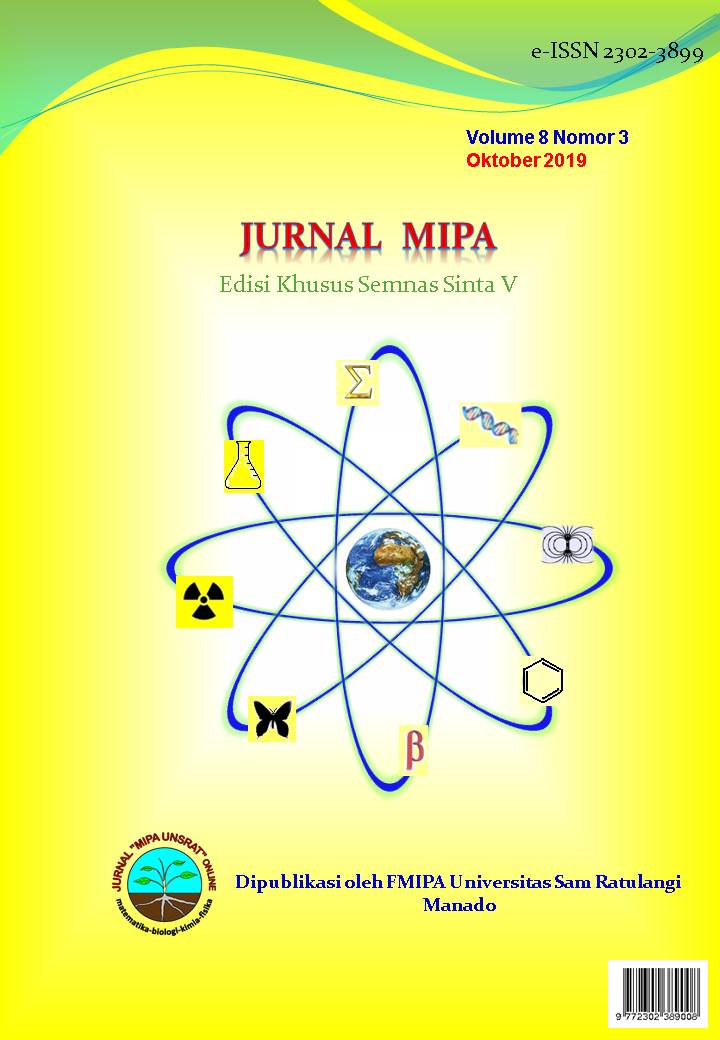Identifikasi Akuifer Di Lahan Pembangunan Tempat Pembuangan Akhir (Tpa) Sampah Di Desa Ilo-Ilo Kecamatan Wori Kabupaten Minahasa Utara
DOI:
https://doi.org/10.35799/jmuo.8.3.2019.26192Abstract
Air tanah adalah air alami yang berada di bawah permukaan tanah yang terkandung di dalam akuifer dan merupakan sumber air bersih. Salah satu syarat hidrogeologi pembangunan TPA sampah adalah tidak terdapat air tanah pada kedalaman yang kurang dari 3 m dari permukaan tanah. Keberadaan akuifer dapat diketahui melalui eksplorasi bawah permukaan dengan metode geolistrik. Identifikasi akuifer telah dilakukan di lahan pembangunan Tempat Pembuangan Akhir (TPA) sampah di desa Ilo-Ilo Kecamatan Wori Minahasa Utara menggunakan resistivity meter dengan konfigurasi dipol-dipol dan spasi elektroda 10 m dalam 4 lintasan pengukuran. Akuifer diidentifikasi dengan nilai resistivitas Ï < 60 Ωm, berada di lintasan 1 pada meter ke 215 sampai meter ke 265 dengan kedalaman 30 m sampai 72 m dari permukaan tanah. Pada lintasan 2 akuifer teridentifikasi pada meter ke 230 sampai meter ke 265 pada kedalaman yang lebih dari 30 m. Akuifer juga teridentifikasi di lintasan 3 pada meter ke 80 menerus sampai meter ke 465 dari permukaan sampai kedalaman lebih dari 90 m namun dengan pola penyebaran yang tidak merata. Pada lintasan 4 akuifer teridentifikasi pada meter ke 215 sampai 250 pada kedalaman lebih dari 26 m
Ground water is that natural water below the soil surface contained in aquifers and a source of clean water. One of the hydrogeological requirements for the construction of landfill waste is the absence of ground water at a depth of less than 3 m from the surface. The existence of aquifers can be known through subsurface exploration by geoelectric method. Aquifer identification has been carried out at the landfill construction site in the village of Ilo-Ilo, Wori, Minahasa Utara District using a resistivity meter with a dipole-dipole configuration with space of electrodes is 10 m in the 4 measurement trajectories. Aquifers is identified with resistivity values Ï <60 Ωm provides in the line 1 at meters of 215 to meters of 265 with a depth of 30 m to 72 m from the ground surface. In the line 2 aquifer is identified at meters of 230 to meters 265 at depth more than 30 m. Aquifers were also identified at line 3 on the meter of 80 continuously up to meter of 465, from the surface to a depth more than 90 m but with unadequate distribution patterns. In the line 4, aquifer is identified at the meter of 215 to meter of 250 in the depths of more than 26 m






